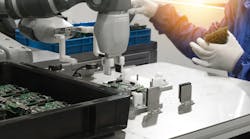As manufacturers across all industries realize that robotics are an investment worth considering, they’re faced with an important question: What type of robot is right for my operation and application? You likely have resources or partners who will help guide or even spec the system for you, but having a good base understanding will help you navigate the waters and ask the right questions.
This first fork in the decision-making tree splits between industrial robots and collaborative robots. Industrial robots are what most people imagine when envisioning a robot on their plant floor — a big, heavy robot caged off, toiling away welding car chassis after chassis twenty-four hours a day with no worker in sight. They excel at their objective, which is to complete dull, dirty, and dangerous tasks. And they do them much faster and more accurately than workers ever could.
Collaborative robots, or “cobots,” are a more recent development where robots work alongside humans rather than replacing them. Cobots, like their industrial counterparts, are designed to perform repetitive, monotonous, or error-prone tasks so humans can focus on work that requires creativity, reasoning, and critical thinking. It’s estimated that cobots currently comprise just three percent of robot sales, but that number is projected to increase to 34 percent by 2025 as adoption accelerates among small and medium-sized manufacturers (SMMs), who frequently operate in the automation-challenged high-mix/low-volume space and are realizing the flexibility that cobots can provide.
For SMMs, understanding the strengths and limitations of both robot types is especially crucial to chart a successful future. Choosing the wrong type can restrict your future growth; choosing the right course can unlock more efficient production and reduce costs for years to come.
Robots: Built for Speed & Power
One of the greatest benefits of industrial robotics is the speed in which they can perform complex tasks and the payloads they can handle, both of which far outpace that of cobots. Because industrial robots are often integrated into more specialized systems than cobots, they can provide an amazing boost to plant production.
But because of the sheer speed and force provided by industrial robots, substantial safety systems are required to ensure tasks are completed in a safe manner. The integration of such a powerful system — and the safeguards it requires — comes with a higher price tag than cobots. Industries that have currently found the right balance with industrial robots include automotive, electronics, metal, plastic and chemical products, as well as food and beverage.
Cobots: Enhanced Abilities
Although cobots operate at lower speeds and payloads than industrial robots, there is real value in how they can augment human abilities, all the while providing benefits both on and off the balance sheet, as well as greater flexibility than an industrial robotic system. In addition, it is often found the the most efficient cell is not 100-percent automated, but rather a combination of automation and operators — queue the cobots.
Cobots are also less expensive and tend to be more easily integrated into the workplace. Cobot deployment can be faster and simpler than for industrial robots, which means less time required for integration and training, and a faster return on your investment.
Part of the decreased cost comes from competition, as new companies have sprung up to meet market demand for cobots, driving down prices. The influx of new companies has also generated momentum in parts and ideas. Third-party developers are creating new accessories, software, and end-of-arm tools that increase the applicability and flexibility of cobots.
With all the excitement surrounding cobots, it can be easy to lose sight of their limitations. While a number of manufacturers (e.g., Fanuc, Doosan, Yaskawa) are growing cobot payload and reach beyond the previous typical ceiling of about 10kg and 1–1.5m respectively, cobots will always have to meet the standards set forth by ANSI, RIA, and ISO (ANSI/RIA R15.06-2012 and ISO 10218-1,2:2011), which limit the speed and payload combination to mitigate risk to surrounding workers. Further, these standards ensure that the robot is collaborative, not the application. In cases where, despite specifying a cobot, your application requires significant safeguards, you may be better served with an industrial robot to then take advantage of its elevated capabilities.
The capability and acceptance of cobots is increasing such that “industrial vs. collaborative” doesn’t really make sense any longer — they are both industrial in their own right in that they are both at home in a manufacturing environment; one is just an industrial robot that is also collaborative. And in the right application, an industrial cobot can provide a cost effective means to improve your operation.
Making the Right Choice
So how can you determine whether a cobot or robot makes the most sense for your shop? Three key factors should be front and center.
First, determine exactly what you want to accomplish, be it increased production, increased worker safety, reduced mistakes, or any number of challenges in your business.
Next, talk to people who can help match available options to meet those goals — organizations such as Catalyst Connection and other Manufacturing Extension Partnership Centers involved in the MEP National Network, a unique public-private partnership that delivers comprehensive, proven solutions to U.S. manufacturers, fueling growth and advancing U.S. manufacturing. They can help connect you with a network of providers and systems integrators to deliver on your project needs and even support you through the processes with services like request for proposal (RFP) development and technical project management.
Lastly, whether on your own or jointly with your chosen partner(s), perform an analysis to see which industrial robot solution makes the best operational and financial sense for your needs — now and into the future.
To learn more about how to make an informed decision about an investment in robotics, download the “Manufacturer’s Guide to Robotics” from MEP National Network representative Catalyst Connection (part of Pennsylvania MEP), which helps small and medium-sized manufacturers navigate technological transformation.
Matt Minner
As the Senior Consultant for Technical Services at Catalyst Connection, part of the MEP National Network, Matt Minner uses his 12-plus years in manufacturing and mining technologies to provide insights on topics ranging from technical strategic planning to automation and robotic implementation.





